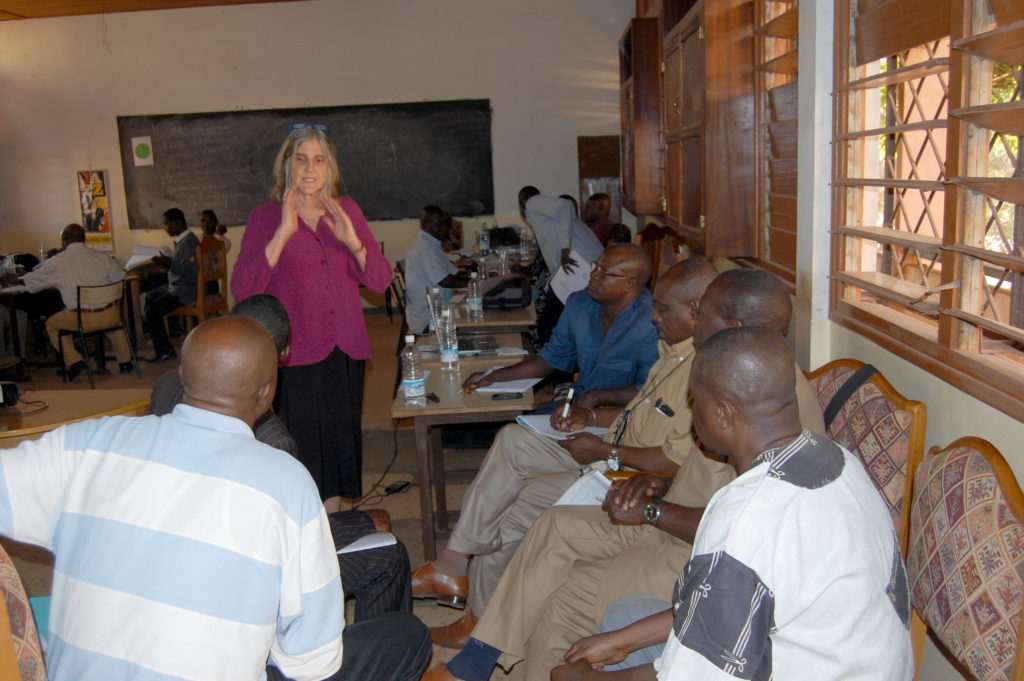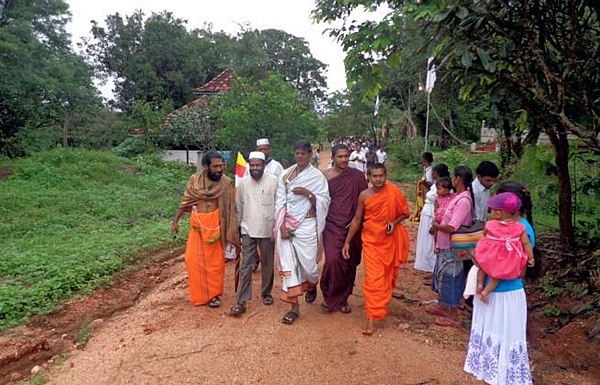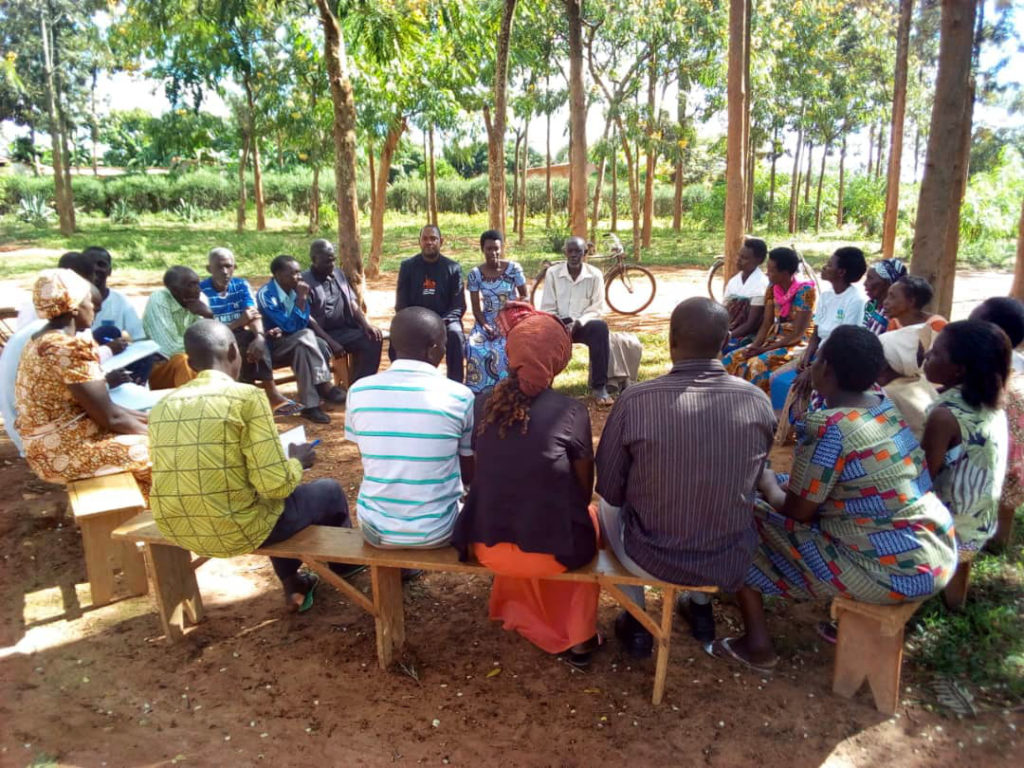A FEW QUESTIONS FOR OLIVIA STOKES DREIER: EXECUTIVE DIRECTOR OF THE KARUNA CENTER FOR PEACEBUILDING

A Few Questions For…” is an occasional feature of The Indy, aimed at helping our readers get to know the folks who are making things happen in our town. We’ll be featuring members of our town government, key town employees, people who lead civic organizations, activists, local educators, prominent volunteers, and residents who are not necessarily well known. This week, we feature a conversation with Olivia Stokes Dreier, Executive Director of the Karuna Centre for Peacebuilding in Amherst. We sat down with Olivia as Karuna prepared to celebrate its twenty-fifth anniversary. Late in the conversation we were joined by Kristine Downing, Karuna’s Coordinator of Local Events.
Background
Located in a small office on West Street in Amherst and with a staff of thirteen, Karuna Center works to empower people divided by conflict to develop mutual understanding and to create sustainable peace. Since 1994, Karuna Center has led initiatives in more than thirty conflict-affected areas worldwide, working across deep divides in order to foster reconciliation, interrupt cycles of violence, and strengthen community resilience. Through collaborations with local partners in conflict-affected areas, they help people discover their shared capacity for building peace. In many cases, participants go on to create their own local peace-building organizations and networks that remain Karuna Center partners. Through dialogue and collaborative projects, Karuna staff guide people who have been separated by violence or injustice discover common aspirations and recognize their common humanity, facilitating new alliances to advocate better violence-prevention policies, bridge divides that threaten future stability, and promote more inclusive societies.
Olivia Stokes Dreier is the Executive Director and a lead trainer at Karuna Center. She has extensive international experience in conflict transformation, including the development, design, and delivery of multi-year programs in peacebuilding, inter-communal dialogue, reconciliation, and conflict-sensitive development for diverse stakeholders. Since 2002, she has designed and led programs in over fifteen countries, including Afghanistan, Azerbaijan, Bosnia-Herzegovina, the Central African Republic, Kosovo, Macedonia, Georgia, Israel, the Palestinian Territories, Sri Lanka, India, Nepal, Pakistan, Rwanda, and Senegal. She frequently conducts conflict assessments, and has consulted with the World Bank and the Asian Development Bank on conflict-sensitive development.

INDY: How did you get started in the work of peacebuilding?
DREIER: For me it was an interesting process. Before I joined Karuna Center, I worked for many years as a psychotherapist – first at UMass and then at Amherst Medical Center, work I very much enjoyed. But, a very formative experience from the middle of my college years kept tugging at me. Between the ages of 20-22, I spent two years working with the Gandhian movement in India with a school affiliated with the Sarvodaya movement, which aims to uplift the poorest people of rural India by peaceful and cooperative means. In the state of Bihar, donated land had been given to those at the bottom of the economic and social ladder. I worked at a school for their kids. They were the very first in their communities to go to school and were being trained to help develop their villages. After that, I went back to Yale and after graduation, my husband [OD1] and I had this vision that we were going to start a therapeutic community based on a farm. That turned out to seem not so realistic when we began to look into what that would cost. But in the meantime I had gotten a masters degree in social work and I proceeded to work as a psychotherapist for the next 15 years. We also helped to start the Hartsbrook School in Hadley. I always had the feeling that I would get involved with something more international once our two sons were older. About the time of the Kosovo war (1998-1999), I began to feel a real disconnect between the insulated life I was living here and what was happening over there, and it felt like it was time for a shift, though it wasn’t yet clear to me what that would be. I did a midcareer masters program at the Kennedy School, as a way to explore what I might do in the international field. I also attended the peacebuilding institute that Paula Green ran up at the School for International Training in Vermont, and went with Paula to Bosnia to observe the work that she was doing there. That was quite profound for me. Paula was facilitating dialogues between Bosnian Serb and Bosnian Muslim educators. I was deeply moved by the power of those dialogues. They were between people who experienced deep mistrust after the war but were then able to reconnect and think together about what it would mean to create a joint future. Happily for me, Paula needed help. Karuna Center was basically her and an administrator working out of her house, and there really weren’t many other NGO’s in the Amherst area doing international peace building. So it just made a lot of sense to join. The Karuna Center at the time had been working on small projects, and I was happy to help Paula grow the organization.
INDY: Could you tell us about one of your more recent projects, one that perhaps epitomizes the work that Karuna is doing and gives us a sense of Karuna’s method for building peace?
DREIER: Let’s talk about our work in Sri Lanka.
The formal project ended a few years ago but we are still involved with work supporting our partners there.
Sri Lanka had been involved in a long civil war (1983-2009). We were offered some funding from the US Institute of Peace during the cease fire, (2003-5) to do peacebuilding with NGO leaders from around the country. We did a lot of exchanges, bringing people from the south up to the north which was still under the control of the Tamil Tigers (a separatist movement that led fighting for am independent homeland for Sri Lanka’s Tamil minority) such that the NGO leaders were exposed to each other’s grievances. Unfortunately, the country then went back to war and then there was a military victory for the Sinhalese dominated government in 2009. That formally ended the bloodshed but there were a lot of human rights abuses right at the end when Tamils were rounded up and many disappeared. The war left deep resentment in its wake from people on all sides of the conflict.
USAID has conflict reconciliation grants that fit well with our mission and we were awarded one to do reconciliation work in Sri Lanka from 2011-2013. We chose to work in the eastern part of the country, which had been the front lines of the war and was traditionally ethnically and religiously mixed. In Sri Lanka, ethnic and religious identity generally go hand in hand – with four major religious/ethnic groups – Buddhist are all Sinhalese, Hindus are all Tamils,, Muslims, who are Tamil speaking, identify as a separate ethnic group, and Christians, who are a small minority are both Tamil and Sinhalese. And after the war, the ethnic tensions among these groups were too strong to address directly. So we chose to work with religious leaders from the four faith groups. This seemed to be politically less fraught as few would object to working with religious leaders and exploring what they might bring from their respective traditions to peacebuilding and reconciliation. But the ethnic tensions came to the surface nonetheless as we began our work. We organized 80 religious leaders – 20 from each faith group and then later in the program another 80 younger leaders.
One thing I should emphasize is that we always try to work closely with local partners and we always put them out front. Our local partner was a large Sri Lankan NGO (that also calls itself Sarvodaya and is modeled after the Indian movement combining principles of Sarvodaya with principles of Buddhism which helped give us cover with the Buddhist-majority government). They were the perfect group to partner with both because they had many village level projects going and because they were seen as ecumenical by all groups– so everyone was comfortable having them host our activities.
We started working with each religious group separately to understand their grievances and gain their trust and then brought them together for some basic peace building training (which helps them to understand each other’s perspective and also teaches some basic skills in dialogue). In their separate groups they had worked out timelines of the history of the conflict as they understood it and then they shared these with each other. This was an eye opening exercise, as their perspectives were so different. Language was a challenge. English is the lingua franca in the capital but in the provinces there often is no common language, and Sinhalese and Tamil are completely unrelated. So we had to use three-way translations. Eventually, the leaders formed inter-faith groups to work on community projects that they had designed to bring people together. As trust began to build – that’s when we began to promote more dialogue work where people could speak quite deeply about their experiences during the war, current tensions, how they saw the future. This happened over the course of about six months – from the start of our first trainings to the deeper dialogues. But working together and building trust was a key to the process.
Eventually the two activities, doing the mutual projects and engaging in deep conversations became mutually reinforcing. And because we had USAID funding, there was money to support the projects. All together they developed some 50 community projects. They did everything from language and computer classes for young people to women’s vocational classes, to creating coops (e.g. a basket making and a tailoring coop), and they were quite creative in developing these projects. The most powerful were projects in which they refurbished each other’s religious sites that were destroyed in the war. For example, there was a Muslim village where the mosque had been severely damaged and they invited people from other communities to come and live with Muslim families for a week while they did this shared work. Apparently it was the first time that non-Muslims had even been in the village and out of this, real relationships were built.

strong relationships during Karuna Center dialogues, led more than 100
Tamil and Muslim congregants in a day of volunteer work at an isolated
Sinhala Buddhist village as a first step toward reintegrating the
area. Photo: Karuna Center for Peacebuilding
The religious leaders decided that one of the important things that they could do was to be highly visible as these interfaith groups undertook their work. So they would organize project launch activities and they would invite the press and governmental officials. They wanted to be an example of inter-faith/inter-ethnic collaboration, and when the young people saw this they took it as approval for them to fraternize and connect.
I remember one time when we asked a group – how was your ethnic group affected by the war and what are your current concerns? We did it as kind of fishbowl exercise where people sat in concentric circles with one faith group forming a circle on the inside speaking to each other and the other groups forming a circle on the outside listening. We didn’t ask them to speak about atrocities, but I remember this one Buddhist monk telling what happened when the Tamil Tigers attacked his monastery where there had been real atrocities. For the Hindu priests in the room, who saw themselves as the victims in the war, it was really eye opening. And then the Muslims described how they had been caught in the crossfire between the two sides. So there was a recognition of how everybody had suffered, and there was something very re-humanizing about it. And I remember – I was struck at the time – that people had spent the better part of a morning talking about these really difficult things. And then we took a coffee break and I saw a Buddhist monk and Hindu priest and an Imam walking arm and arm with big grins.
I think for us, it is those moments when people, through the dialogue process, recognize their common humanity – that is deeply transformational. And then, if that can be reinforced by opportunities to work together visibly in the community, that’s when it becomes more than just talk – that’s the thing that ripples out.
And we’re always thinking about sustainability. At the end of our project, the people came up with the idea of interfaith councils to keep the work going, including preventive work around conflict. And we continue to support them in this work with small grants.
Of course, not everyone embraces this work. The most nationalist Buddhist monastery in the area, for example, refused to participate. So we work with the willing and then strategize with them about how they might reach out and expand the work.
One more key to the work – we always try to have some link with policy makers because we are always mindful that while we want to change attitudes and practices – we also want to see structures change. So we ended our project with a national conference on reconciliation that was televised nationally.
INDY: How does transformational work with a relatively small group of people scale up into peacebuilding, especially in places that have been enveloped in war for a long time?
DREIER: In Sri Lanka, we chose a local partner that had great reach. And they were already engaged in sustainable work. And the projects expand out so our community projects that began with 80 religious leaders probably reached about 5000 people.
The women’s basket making coop was comprised of Hindu and Muslim women whose communities had a lot of tension because of stuff that happened in the war and there were ongoing gang activities that sustained conflict between the communities. The women developed, on their own, a kind of early warning system to track when trouble was brewing and to sometimes facilitate intervention. And so that’s one way that things rippled out beyond the initial project. Of course scaling up is a challenge. The intense people-to-people work can only reach small numbers. The community projects expand this work outward.
INDY: Does this kind of work, in a way, inoculate communities against future flareu ps of violence? In learning to embrace each other’s humanity, have you helped people tell a different kind of story that then frames an alternative reality and alternative set of possibilities—a story that defies the dominant narrative that fed the conflict in the first place?
DREIR; It’s all very context specific – the political situation and how far things can go. In Sri Lanka, with the younger generation, you could feel a kind of longing to connect. This was their parents’ war, not theirs. So it took very little to get them to connect. When we did the joint language trainings or computer trainings – in no time at all they were friending each other on Facebook and texting and it was like as soon as they had permission they really wanted to connect. And we found this to be true of the younger generation in Rwanda as well.

IINDY: Can you say just a few more words about your method? Clearly in your work in both Rwanda and Sri Lanka you have given the younger generation not just an alternative narrative but some tools. Can you say a few words about those tools?
DREIER: All of our work is context specific so the most important thing we do is to learn everything we can about the context before we go in. We are careful not to assume that what has worked in one place will work in another. We need to be sensitive to the layers of political complexity because we want to create openings for connection and collaboration and healing but not in a way that is going to produce a lot of push back. Our motto is we bridge divides to build sustainable peace. But what the divides are and how we build the bridge—that varies from place to place.
Other elements of our method include:
- Having strong local partners
- Co-designing projects around what local people see as the most pressing needs
- Dialogue that allows people who have become alienated from or dehumanized by one another due to violence—or who simply hold starkly different views—to develop mutual understanding and find ways to work together
- Conflict transformation that helps participants analyze the social, political, and economic factors that contribute to conflict, recognizing that conflict transformation requires both individual and systemic change
- Sustainable peace building efforts to enhance the local capacity to respond effectively and nonviolently to future conflicts
- Story Telling. It’s the stories of atrocities that often linger so we try to help people spread stories of reconciliation so that they can see/imagine the power and potential of reconciliation.
INDY: It sounds like underlying it all is a therapeutic core. You and Paula both come from therapeutic backgrounds and it seems like a primary goal is to promote healing.
DREIER: Yes. People come in individually wounded and there is also a need for a kind of social healing. Beginning in the 90’s there were so many civil wars where neighbor was pitted against neighbor and the whole social fabric was torn apart – so you can have a peace settlement but that doesn’t begin to address this total breakdown of trust at the local level.
INDY: Your reach is pretty amazing—thirty countries all over the world!
DREIER: Yes but of course we’re not in all of them at once. Right now we have three major projects going in Bosnia, Rwanda and Nigeria . Our project in Nigeria is addressing farmer/herder conflicts which have been exacerbated by climate change. And where we work is limited by the availability of funding. Sometimes people invite us to work with them but we are unable to because of a lack of funding.
INDY: Let’s see if we can connect your work back to local issues. Right now, the country feels really polarized. And I think that’s the case here in Amherst, too, where resentments from some recent, bitterly contested elections linger. Do you have anything to say to folks in Amherst who think that things are really messed up, fraught, or polarized, and would like to do something about it?
DOWNING: I’ve been thinking about this lately. The work that we do internationally, it is just so unbelievably powerful —that victims and perpetrators can come together and talk with each other in Rwanda…but we don’t even talk to our neighbors here at home when we have different political opinions. I feel like people have to be willing to talk to each other, consider the positions of others, and make an effort to understand where the other person is coming from. I do think that what people are divided over is important and it should not be trivialized. But people in other places are doing the work of talking to each other about their differences and we can do that here too.
INDY: Would you tell us a bit about your local initiatives?
DOWNING: We have a community discussion and speaker series we co-convene with Critical Connections, which is an organization founded by our friend and colleague Mehlaqa Samdani to educate the larger community on issues related to American-Muslims and other targeted groups in the U.S. We’ve been doing community events with them for 4-5 years. Initially, we worked together on Muslim/non-Muslim issues and since the recent elections we have been working on divisions more broadly. This year our focus is going to be on white identity. Tonight we’ll be looking at the ideology and hidden premises of white supremacy and its current resurgence, and we’ll consider our own role in this and how we can combat it. Throughout the series we’ll also be talking about how white supremacy shows up in our elections. In the fall term we will emphasize white supremacy and in the spring term will look at the indigenous history of the Pioneer Valley. The events are free and open to the public, and each is independent of the other so attendance at one is not required to attend others.
Also this year, we’re sponsoring a series of events on reparations. Last year we held a public lecture on reparations that received a lot of positive response and so we decided to build on that and do a series that will look at the different forms that reparations can take in the United States and how this can be a tool for building peace. And then we want to consider how that can happen in our community so we will bring together people with land and resources and people seeking reparations to engage in dialogues about reparations to experience what healing and peace building work can look like here.
INDY: As Olivia noted in mentioning your new project in Nigeria, the climate crisis can exacerbate existing conflicts and create new ones and that makes the process of peace building harder. Can you say a few words about the work that you have undertaken re: the climate crisis?
DOWNING: The climate crisis is a global phenomenon that plays a major role in far too many conflicts. We cannot begin to understand the drivers of a specific conflict, such as the farmer/herder conflict in Nigeria, without understanding the effects of climate change in these areas. Many times, drivers of conflict get reduced to political, ethnic, or religious reasons when dwindling resources is often a major exacerbating element and ignoring this can be detrimental. There is some information on ourweb site and your readers can get some sense of it here.
INDY: Thank you so much for taking the time to tell us about your work. Is there anything else you would like to add?
DOWNING: Sure. You know, we can struggle with confidence about our own agency, our own capacity to make change, all the time. I think the advice I would leave for people who are having trouble getting started is to start small. There’s this Mother Theresa quote that I really like, “Not all of us can do great things. But we can do small things with great love.” One thing we can all do is reach out to our neighbors and talk to them. And we can show up at events like these community dialogues and learn a little bit more about things like white supremacy and how we can stand up to it. These are manageable starting points that anyone can do.
To hear more stories of peacebuilding from Olivia and the Karuna Center, join them for a celebration of twenty-five years of building peace at the Amherst Woman’s Club on October 12, 5:30-7:30 p.m. Free and open to the public.


